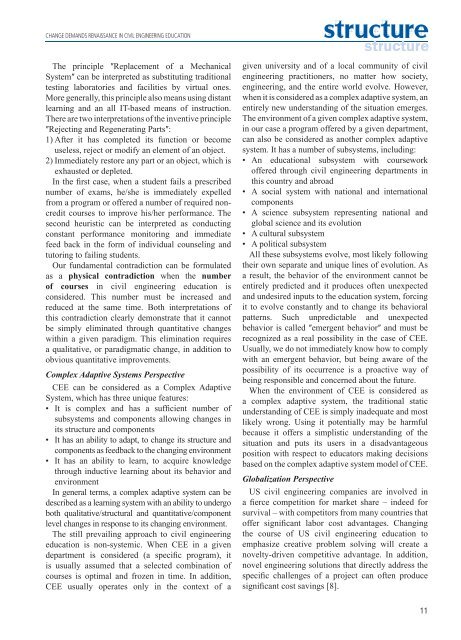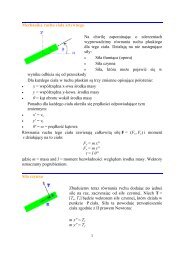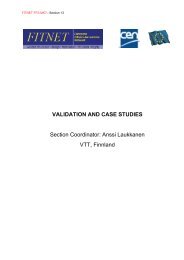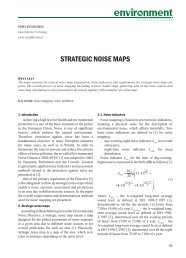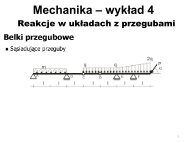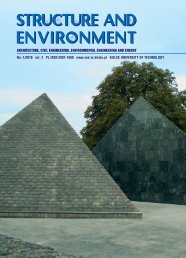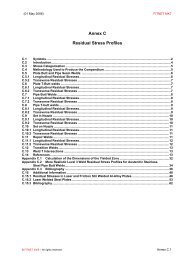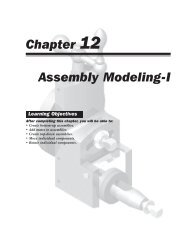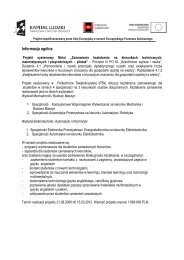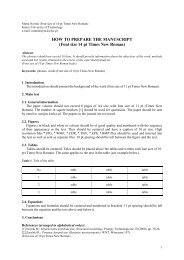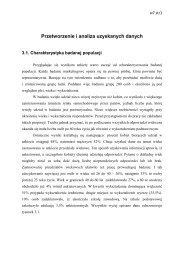STRUCTURE AND ENVIRONMENT STRUCTURE AND ...
STRUCTURE AND ENVIRONMENT STRUCTURE AND ...
STRUCTURE AND ENVIRONMENT STRUCTURE AND ...
Create successful ePaper yourself
Turn your PDF publications into a flip-book with our unique Google optimized e-Paper software.
CHANGE DEM<strong>AND</strong>S RENAISSANCE IN CIVIL ENGINEERING EDUCATION<br />
The principle ʺReplacement of a Mechanical<br />
Systemʺ can be interpreted as substituting traditional<br />
testing laboratories and facilities by virtual ones.<br />
More generally, this principle also means using distant<br />
learning and an all IT-based means of instruction.<br />
There are two interpretations of the inventive principle<br />
ʺRejecting and Regenerating Partsʺ:<br />
1) After it has completed its function or become<br />
useless, reject or modify an element of an object.<br />
2) Immediately restore any part or an object, which is<br />
exhausted or depleted.<br />
In the first case, when a student fails a prescribed<br />
number of exams, he/she is immediately expelled<br />
from a program or offered a number of required noncredit<br />
courses to improve his/her performance. The<br />
second heuristic can be interpreted as conducting<br />
constant performance monitoring and immediate<br />
feed back in the form of individual counseling and<br />
tutoring to failing students.<br />
Our fundamental contradiction can be formulated<br />
as a physical contradiction when the number<br />
of courses in civil engineering education is<br />
considered. This number must be increased and<br />
reduced at the same time. Both interpretations of<br />
this contradiction clearly demonstrate that it cannot<br />
be simply eliminated through quantitative changes<br />
within a given paradigm. This elimination requires<br />
a qualitative, or paradigmatic change, in addition to<br />
obvious quantitative improvements.<br />
Complex Adaptive Systems Perspective<br />
CEE can be considered as a Complex Adaptive<br />
System, which has three unique features:<br />
• It is complex and has a sufficient number of<br />
subsystems and components allowing changes in<br />
its structure and components<br />
• It has an ability to adapt, to change its structure and<br />
components as feedback to the changing environment<br />
• It has an ability to learn, to acquire knowledge<br />
through inductive learning about its behavior and<br />
environment<br />
In general terms, a complex adaptive system can be<br />
described as a learning system with an ability to undergo<br />
both qualitative/structural and quantitative/component<br />
level changes in response to its changing environment.<br />
The still prevailing approach to civil engineering<br />
education is non-systemic. When CEE in a given<br />
department is considered (a specific program), it<br />
is usually assumed that a selected combination of<br />
courses is optimal and frozen in time. In addition,<br />
CEE usually operates only in the context of a<br />
given university and of a local community of civil<br />
engineering practitioners, no matter how society,<br />
engineering, and the entire world evolve. However,<br />
when it is considered as a complex adaptive system, an<br />
entirely new understanding of the situation emerges.<br />
The environment of a given complex adaptive system,<br />
in our case a program offered by a given department,<br />
can also be considered as another complex adaptive<br />
system. It has a number of subsystems, including:<br />
• An educational subsystem with coursework<br />
offered through civil engineering departments in<br />
this country and abroad<br />
• A social system with national and international<br />
components<br />
• A science subsystem representing national and<br />
global science and its evolution<br />
• A cultural subsystem<br />
• A political subsystem<br />
All these subsystems evolve, most likely following<br />
their own separate and unique lines of evolution. As<br />
a result, the behavior of the environment cannot be<br />
entirely predicted and it produces often unexpected<br />
and undesired inputs to the education system, forcing<br />
it to evolve constantly and to change its behavioral<br />
patterns. Such unpredictable and unexpected<br />
behavior is called ʺemergent behaviorʺ and must be<br />
recognized as a real possibility in the case of CEE.<br />
Usually, we do not immediately know how to comply<br />
with an emergent behavior, but being aware of the<br />
possibility of its occurrence is a proactive way of<br />
being responsible and concerned about the future.<br />
When the environment of CEE is considered as<br />
a complex adaptive system, the traditional static<br />
understanding of CEE is simply inadequate and most<br />
likely wrong. Using it potentially may be harmful<br />
because it offers a simplistic understanding of the<br />
situation and puts its users in a disadvantageous<br />
position with respect to educators making decisions<br />
based on the complex adaptive system model of CEE.<br />
Globalization Perspective<br />
US civil engineering companies are involved in<br />
a fierce competition for market share – indeed for<br />
survival – with competitors from many countries that<br />
offer significant labor cost advantages. Changing<br />
the course of US civil engineering education to<br />
emphasize creative problem solving will create a<br />
novelty-driven competitive advantage. In addition,<br />
novel engineering solutions that directly address the<br />
specific challenges of a project can often produce<br />
significant cost savings [8].<br />
11


